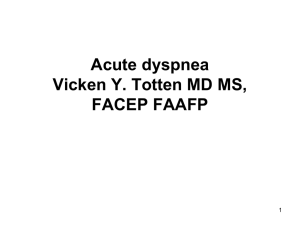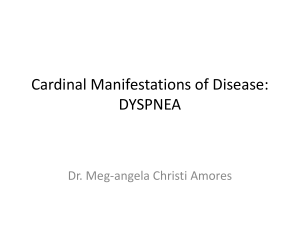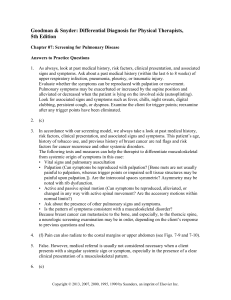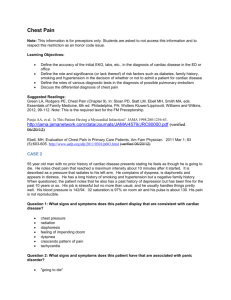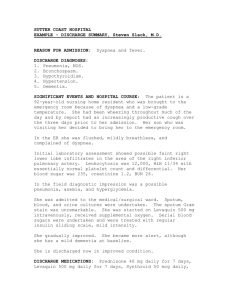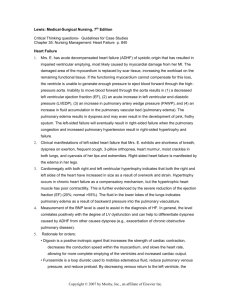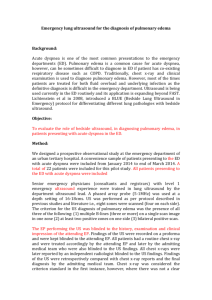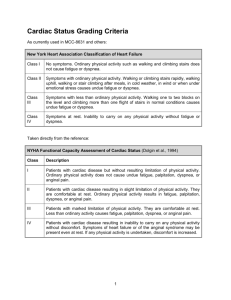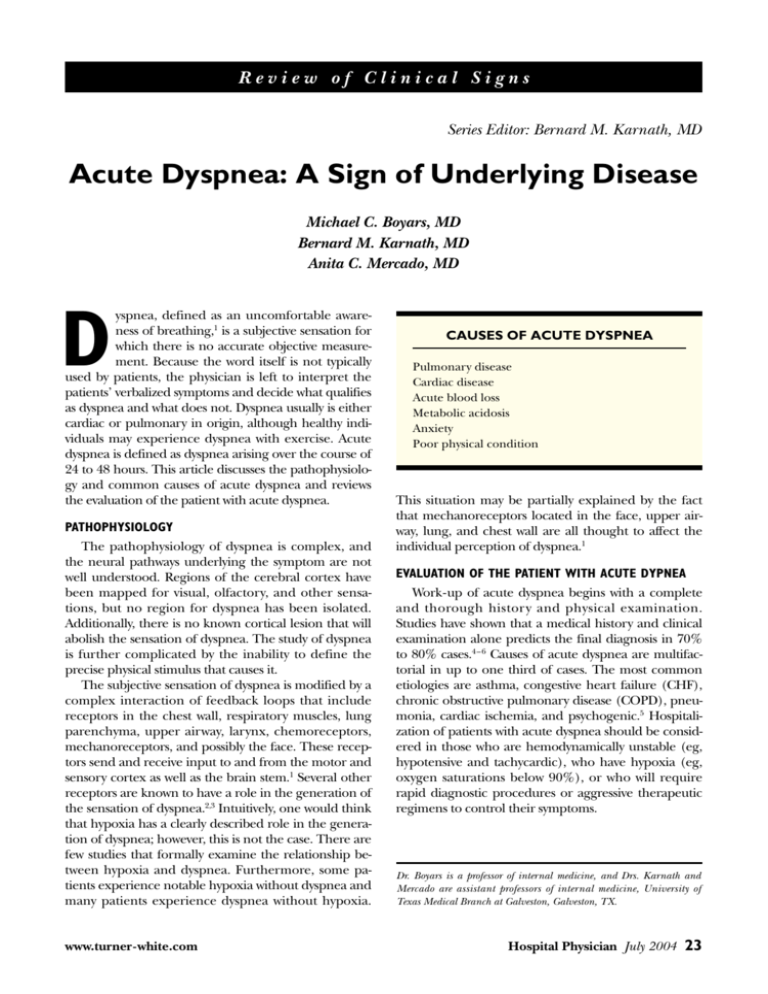
Review of Clinical Signs
Series Editor: Bernard M. Karnath, MD
Acute Dyspnea: A Sign of Underlying Disease
Michael C. Boyars, MD
Bernard M. Karnath, MD
Anita C. Mercado, MD
yspnea, defined as an uncomfortable awareness of breathing,1 is a subjective sensation for
which there is no accurate objective measurement. Because the word itself is not typically
used by patients, the physician is left to interpret the
patients’ verbalized symptoms and decide what qualifies
as dyspnea and what does not. Dyspnea usually is either
cardiac or pulmonary in origin, although healthy individuals may experience dyspnea with exercise. Acute
dyspnea is defined as dyspnea arising over the course of
24 to 48 hours. This article discusses the pathophysiology and common causes of acute dyspnea and reviews
the evaluation of the patient with acute dyspnea.
D
PATHOPHYSIOLOGY
The pathophysiology of dyspnea is complex, and
the neural pathways underlying the symptom are not
well understood. Regions of the cerebral cortex have
been mapped for visual, olfactory, and other sensations, but no region for dyspnea has been isolated.
Additionally, there is no known cortical lesion that will
abolish the sensation of dyspnea. The study of dyspnea
is further complicated by the inability to define the
precise physical stimulus that causes it.
The subjective sensation of dyspnea is modified by a
complex interaction of feedback loops that include
receptors in the chest wall, respiratory muscles, lung
parenchyma, upper airway, larynx, chemoreceptors,
mechanoreceptors, and possibly the face. These receptors send and receive input to and from the motor and
sensory cortex as well as the brain stem.1 Several other
receptors are known to have a role in the generation of
the sensation of dyspnea.2,3 Intuitively, one would think
that hypoxia has a clearly described role in the generation of dyspnea; however, this is not the case. There are
few studies that formally examine the relationship between hypoxia and dyspnea. Furthermore, some patients experience notable hypoxia without dyspnea and
many patients experience dyspnea without hypoxia.
www.turner-white.com
CAUSES OF ACUTE DYSPNEA
Pulmonary disease
Cardiac disease
Acute blood loss
Metabolic acidosis
Anxiety
Poor physical condition
This situation may be partially explained by the fact
that mechanoreceptors located in the face, upper airway, lung, and chest wall are all thought to affect the
individual perception of dyspnea.1
EVALUATION OF THE PATIENT WITH ACUTE DYPNEA
Work-up of acute dyspnea begins with a complete
and thorough history and physical examination.
Studies have shown that a medical history and clinical
examination alone predicts the final diagnosis in 70%
to 80% cases.4 – 6 Causes of acute dyspnea are multifactorial in up to one third of cases. The most common
etiologies are asthma, congestive heart failure (CHF),
chronic obstructive pulmonary disease (COPD), pneumonia, cardiac ischemia, and psychogenic.5 Hospitalization of patients with acute dyspnea should be considered in those who are hemodynamically unstable (eg,
hypotensive and tachycardic), who have hypoxia (eg,
oxygen saturations below 90%), or who will require
rapid diagnostic procedures or aggressive therapeutic
regimens to control their symptoms.
Dr. Boyars is a professor of internal medicine, and Drs. Karnath and
Mercado are assistant professors of internal medicine, University of
Texas Medical Branch at Galveston, Galveston, TX.
Hospital Physician July 2004
23
Boyars et al : Acute Dyspnea : pp. 23 – 27
Table 1. Differentiating History and Physical Examination
Findings for Cardiac and Pulmonary Causes of Dyspnea
History
Cardiac Disease
Pulmonary Disease
Dyspnea on exertion
Dyspnea with rest and
exertion
Paroxysmal nocturnal
dyspnea
Tobacco use
Orthopnea
Cough
Associated chest pain
Sputum production
Wheezing
Pleuritic chest pain
Physical
Jugular venous
examination distention
Expiratory wheezes
Decreased air movement
Peripheral edema
Resonance to percussion
Ascites
Barrel-chested physique
Pleural effusions
Pulmonary edema
Cardiomegaly
S3 gallop
Adapted from Sherman DL, Ryan TJ. Differentiating cardiac and pulmonary causes of dyspnea. ACC Curr J Rev 1995;4:65 with permission
from Elsevier.
History
History taking should be tailored to include information pertinent to evaluating potential etiologies for
dyspnea. Pulmonary and cardiac disease are responsible for the vast majority of cases; therefore, special
attention should be given to these possibilities. Table 1
outlines the differentiating history and physical examination findings for cardiac and pulmonary disease.
Table 2 lists the major causes of acute dyspnea.
Pre-existing pulmonary or cardiac disease should
be noted because the presence of either makes recurrence or exacerbation of the underlying process more
likely. Acute dyspnea in a patient with underlying
COPD is likely to indicate an acute exacerbation of
COPD. Information about the onset, timing, associated symptoms, severity, and exacerbating and relieving
factors obviously are important. Physicians should
specifically ask about the presence of pedal edema,
paroxysmal nocturnal dyspnea, orthopnea, angina, or
palpitations; these symptoms may indicate occult heart
disease. Wheezing, cough, sputum production, hemoptysis, recent upper respiratory infection, or a history of smoking may suggest a pulmonary etiology for
the dyspnea. In addition, the occupational history may
point to a pulmonary cause (eg, sandblasting and silicosis or pipefitting and asbestosis).
Additional medical history findings that may be
helpful include the presence of fever, chills, night
24 Hospital Physician July 2004
sweats, weight loss, change in appetite, chest pain/
pleurisy, recent trauma, or symptoms of gastroesophageal reflux disease. A detailed medication history
always should be taken. Drugs may cause hemolytic
anemia (quinidine and penicillin); methemoglobinemia (nitrites and nitrates); sulfhemoglobinemia (dapsone and sulfonamides); and acute or chronic fibrosis
(nitrofurantoin or amiodarone). Aspirin sensitivity is a
cause of asthma in a significant number of patients.
Acute myocardial infarction (MI) is an important
cause of acute dyspnea. A study evaluating the frequency of symptoms among 88 patients who presented with
acute MI found that 47% reported shortness of breath.7
The most common symptoms of acute MI in this study
were chest pain and diaphoresis, occurring in 64% and
78% of patients, respectively.7 Angina pectoris is defined as chest pain of cardiac origin due to an imbalance between myocardial oxygen supply and demand.
Patients frequently describe the discomfort as a heavy
pressure or squeezing that usually is brought on by
exertion. Associated symptoms include dyspnea, diaphoresis, nausea, vomiting, and weakness.
Details in the past medical history may useful for
establishing a diagnosis. History of proximal deep
venous thrombosis should prompt a search for pulmonary thromboembolism or pulmonary hypertension. Previous history of cancer, particularly breast or
bronchogenic, should raise the suspicion of a malignant pleural effusion. Although usually associated with
chronic dyspnea, previous thoracic radiation and
chemotherapy with busulfan or other agents are known
to be associated with pulmonary fibrosis, which may
present with acute dyspnea.
Physical Examination
Results of the physical examination can direct the
physician toward a specific diagnosis. General assessment of the patient may yield such information as
severity of dyspnea, presence of tachypnea, central or
peripheral cyanosis, presence of pursed lip breathing
(indicative of severe obstructive lung disease), central
obesity consistent with obstructive sleep apnea, or
extreme cachexia (suggestive of malignancy). Pallor
raises anemia as a consideration. The pharynx should
be examined for signs of obstruction or enlarged tonsils, which may predispose to obstructive sleep apnea.
Stridor, indicative of an upper airway obstruction from
laryngospasm, tumor, or vocal cord dysfunction,
should be sought.
Auscultation of the lung fields can elicit further evidence of a pulmonary etiology. A localized wheeze may
be evidence of foreign body or tumor. Decreased or
www.turner-white.com
Boyars et al : Acute Dyspnea : pp. 23 – 27
absent breath sounds unilaterally may represent pneumothorax (when accompanied by hyperresonance to
percussion) or pleural effusion (when accompanied by
dullness to percussion). Crackles or rhonchi are indicative of pneumonia, pulmonary fibrosis, or pulmonary
edema. Wheezing, a prolonged expiratory phase of
respiration, increased lung fields by percussion, or palpable liver without hepatomegaly is indicative of obstructive airway disease. Pleural friction rubs may be a
sign of pleurisy or pulmonary infarction.
CHF is suggested by the presence of an S3 gallop,
bibasilar crackles, elevated jugular venous pressure, a
laterally displaced point of maximal cardiac impulse,
and/or peripheral edema. S3 gallop, a sign of left ventricular failure, can be heard in conditions resulting in
rapid ventricular filling and volume overloading, such
as mitral or aortic insufficiency. An S3 gallop is low
pitched and is heard best at the apex with the bell of
the stethoscope. An increased pulmonic S2, right ventricular heave, and elevated jugular venous pressure
are indicative of pulmonary hypertension.
S4 (atrial gallop) in a patient presenting with acute
dyspnea is suggestive of decreased left ventricular compliance. S4 is a presystolic, low-pitched sound that occurs just before S1 and is heard best at the apex with the
bell of the stethoscope. S4 is encountered in conditions
that cause decreased ventricular compliance such as
hypertension, aortic stenosis, coronary artery disease,
acute MI, and hypertrophic cardiomyopathy. These
conditions cause increased resistance to ventricular filling following atrial contraction.
Evidence of deep venous thrombosis may indicate
the presence of a pulmonary thromboembolism. Most
pulmonary embolisms arise from venous thromboembolisms of the lower extremity. The possibility of pulmonary embolism is suggested by the acute onset of
dyspnea, pleuritic chest pain, severe hypoxia, and risk
factors such as recent surgery, underlying malignancy,
and a bedridden or sedentary state. One study found
that the most common symptoms of pulmonary
embolism include dyspnea (73%), pleuritic pain (66%),
cough (37%), lower extremity edema (28%), and
hemoptysis (13%).8 Physical signs included crackles on
lung auscultation (51%), and tachycardia (30%).8
Table 2. Causes of Acute Dyspnea
Laboratory Examination
The laboratory work-up of dyspnea is directed by
the results of the history and physical examination.
Chest radiograph, oxygen saturation, arterial blood gas
(ABG) analysis, electrocardiogram (ECG), echocardiogram, and cardiac enzyme levels may help differentiate
between an acute pulmonary versus an acute cardiac
Anxiety/psychogenic
www.turner-white.com
Pulmonary
Airway obstruction
Foreign body, tumor/secretion/edema/inflammation
Acute exacerbation of chronic obstructive pulmonary disease
Parenchymal disease
Infection
Malignancy
Primary
Metastatic
Atelectasis
Vascular disease
Thromboembolus/tumor embolus/fat embolus
Pulmonary hypertension
Vasculitis
Pulmonary edema
Noncardiogenic
Pleural disease
Effusion
Pneumothorax
Cardiac
Ischemic disease
Valvular disease
Septal defects
Cardiomyopathy
Myxoma
Pericardial disease
Effusion
Pericarditis
Other
Respiratory muscles/thoracic cage
Systemic neuromuscular disease
Phrenic nerve dysfunction
Anemia/hemoglobinopathy
Decreased/abnormal hemoglobin
Carboxyhemoglobin
Metabolic acidosis
Hyperthyroidism
Ascites
Gastroesophageal reflux disease
etiology. A ventilation-perfusion scan and/or a lower
extremity Doppler study should be performed if
pulmonary thromboembolism is suspected.
In patients presenting with an exacerbation of
Hospital Physician July 2004
25
Boyars et al : Acute Dyspnea : pp. 23 – 27
ILLUSTRATIVE CASES
Case 1 Presentation
A 75-year-old man with a past medical history of
coronary artery disease presents with a 1-day history of
dyspnea, right-sided chest pain, and cough with rustcolored sputum. Further history reveals subjective fever
and chills. His physical activity level has diminished over
the last 2 days. Physical examination reveals the patient
to be mildly tachypneic and afebrile but in no acute distress. Cardiac examination is without significant findings. There are crackles and a friction rub in the right
anterior lung field. Laboratory examination demonstrates a mild leukocytosis and a Pao2 of 60 mm Hg.
Figure 1. Chest radiograph for patient 1, revealing a right
upper lobe infiltrate.
COPD or asthma, measurement of oxygen saturation is
essential. Pulse oximetry is an effective screening tool
for detecting hypoxia, and it has the advantage of lower
cost and discomfort to the patient compared with ABG
sampling. Pulse oximetry also is easy to use, and it provides immediate results and continuous assessment.
However, an ABG analysis may be needed in the initial
assessment of a chronic smoker with acute dyspnea
because of elevated carboxyhemoglobin levels caused
by smoking. Carbon monoxide causes the pulse oximeter to overestimate the arterial oxygen saturation, especially when carboxyhemoglobin levels exceed 2%.9
For patients presenting with acute chest pain, the
ECG is the most important initial laboratory examination. A prospective study of 247 patients who presented
to an emergency department with acute chest pain
found that the initial history, physical examination,
and ECG are the most important predictors of cardiac
events, with a 96% sensitivity of predicting a cardiac
event.10 The addition of cardiac marker data, including
serum troponin I levels, did not improve the positive
predictive value in this patient population beyond that
of the history, physical examination, and ECG.10
CHF is a very common clinical problem among the
elderly and often is misdiagnosed in an urgent care setting because of nonspecific symptoms. B-type natriuretic peptide (BNP), a cardiac neurohormone, recently has been identified to have diagnostic potential
in patients with left ventricular dysfunction.11 BNP is
released by the ventricles in response to increased enddiastolic pressure or volume expansion. A BNP level of
100 pg/mL is highly indicative of decompensated
heart failure.11
26 Hospital Physician July 2004
Discussion
In this patient, the differential diagnosis includes
pulmonary thromboembolism, CHF, acute MI, COPD
exacerbation, pneumothorax, pleural effusion, and
pneumonia. Findings of new onset dyspnea, chest pain,
hypoxemia, and friction rub all are consistent with a
diagnosis of pneumonia and pulmonary thromboembolism. However, a new cough with sputum production
would be unusual in pulmonary thromboembolism.
Neither the history nor the physical examination yields
signs or symptoms of acute cardiac decompensation
that would indicate a cardiac etiology. There are no
findings consistent with pneumothorax or pleural effusion, and the unilateral findings make a COPD exacerbation unlikely. A chest radiograph is ordered and is
consistent with pneumonia (Figure 1).
Case 2 Presentation
A 50-year-old man presents with complaints of chest
pain and dyspnea for the past 6 hours. He describes the
pain as a tightness that is substernal in location, mainly
on the left side. The pain radiates to his left arm and
left jaw. Physical examination reveals blood pressure of
150/90 mm Hg and pulse of 110 bpm. Cardiac examination reveals an S4 gallop but no murmurs. Lung
examination reveals crackles at the bases bilaterally. An
ECG is ordered (Figure 2).
Discussion
In this patient, the main diagnostic consideration is
an acute coronary event because dyspnea frequently
accompanies cardiac symptoms. The dyspnea seen in
patient 2 is caused by pulmonary edema related to
acute left ventricular dysfunction. The crackles detected on lung examination are consistent with CHF. The
ECG confirms acute MI as the cause. Further studies,
such as cardiac catheterization and echocardiogram,
also should be considered.
www.turner-white.com
Boyars et al : Acute Dyspnea : pp. 23 – 27
Figure 2. Electrocardiogram for patient 2, showing an ST-segment elevation in the anterior segment (V1–V4) that is consistent
with acute anteroseptal myocardial infarction.
CONCLUSION
Acute dyspnea is a common symptom seen in clinical practice. It is most commonly pulmonary or cardiac
in origin. A thorough history and physical examination
are important for effectively directing the work-up. HP
REFERENCES
1. Manning HL, Schwartzstein RM. Pathophysiology of
dyspnea. N Engl J Med 1995;333:1547–53.
2. Banzett RB, Lansing RW, Reid MB, et al. ‘Air hunger’
arising from increased PCO2 in mechanically ventilated
quadriplegics. Respir Physiol 1989;76:53–67.
3. Banzett RB, Lansing RW, Brown R, et al. ‘Air hunger’
from increased PCO2 persists after complete neuromuscular block in humans. Respir Physiol 1990;81:1–17.
4. Schmitt BP, Kushner MS, Weiner SL. The diagnostic usefulness of the history of the patient with dyspnea. J Gen
Intern Med 1986;1:386–93.
5. Michelson E and Hollrah S. Evaluation of the patient
with shortness of breath: an evidence based approach.
Emerg Med Clin North Am 1999;17:221–37, x.
6. Mulrow CD, Lucey CR, Farnett LE. Discrimating causes
of dyspnea through clinical examination. J Gen Intern
Med 1993;8:383–92.
7. Horne R, James D, Petrie K, et al. Patients’ interpretation
of symptoms as a cause of delay in reaching hospital during acute myocardial infarction. Heart 2000;83:388–93.
8. Stein PD, Terrin ML, Hales CA, et al. Clinical, laboratory,
roentgenographic, and electrocardiographic findings in
patients with acute pulmonary embolism and no preexisting cardiac or pulmonary disease. Chest 1991;100:
598–603.
9. Lee WW, Mayberry K, Crapo R, Jensen RL. The accuracy of pulse oximetry in the emergency department. Am
J Emerg Med 2000;18:427–31.
10. Sonel AF, Whittle J, Kelley M, Wilensky RL. Is there still a
role for physician assessment in the emergency department in the era of novel cardiac markers [abstract]? J
Am Coll Cardiol 2002;39(Suppl 2):316A.
11. Segev G, Lewis JF. B-type natriuretic peptide: a novel
clinical tool for diagnosis and management of heart failure. Hosp Physician 2003;39:19–24.
Copyright 2004 by Turner White Communications Inc., Wayne, PA. All rights reserved.
www.turner-white.com
Hospital Physician July 2004
27

